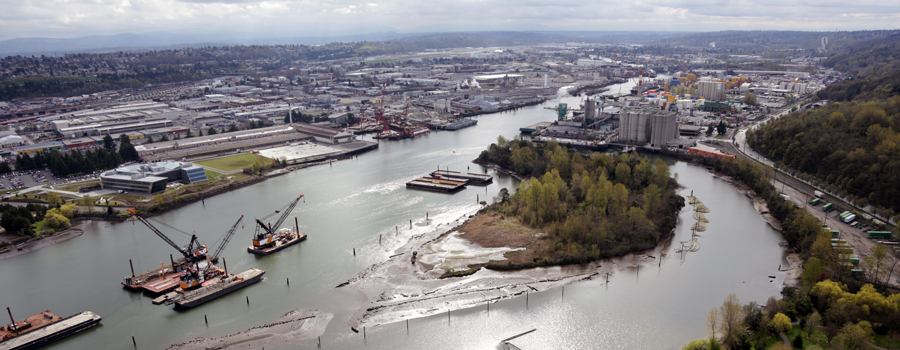
Salmon Habitat Recovery
Chinook salmon, bull trout, and steelhead are listed as threatened under the Endangered Species Act. In the Green/Duwamish and Central Puget Sound Watershed (WRIA 9), citizens, scientists, businesses, conservation groups, and governments are working together to respond to the decline of salmon and the lands and waters on which the fish depend. In 2005, the partners completed a science-based Salmon Habitat Plan. Carrying out the plan recommendations will protect and restore a healthy watershed ecosystem for both people and fish. Watershed salmon habitat recovery is part of the work of the Puget Sound Partnership. Funding for coordination of salmon habitat recovery is provided by 17 local governments in the watershed. More information about WRIA 9.
The Source Control Work Group
The Washington State Department of Ecology leads the Source Control Work Group, which consists of the EPA, King County, the City of Seattle, the Port of Seattle and other agencies. Members share information, discuss strategy, develop action plans, implement source control measures, and track their progress.
The Lower Duwamish Waterway Group (LDWG)
In 2000, the County joined with the Port of Seattle, City of Seattle and The Boeing Company to form LDWG. This cooperative partnership began work to investigate and clean up contaminated sediments in the waterway. U.S. EPA then listed the Lower Duwamish as a Superfund site in 2001. Together, the four parties are helping to define a strategy for the cleanup. The overall goal of the cleanup is to develop a process for managing contaminated sediments in the waterway, and to reduce risks to fish, wildlife and people who use the river for recreation and tribal net fishing. Learn more about King County’s work with LDWG.
Green Duwamish Watershed Strategy
King County and the City of Seattle have teamed up to improve conditions throughout the watershed surrounding the Green and Duwamish rivers, stretching 93 miles from the Cascades to Elliott Bay. The Our Green/Duwamish project aims to coordinate the work already being done by local, state, federal agencies, tribes and community groups to manage habitat restoration, salmon recovery, flood control, public health, economic development, and more. Learn more:
Business community
The business community in the Duwamish River basin is an important and valued partner. The cleanup provides an opportunity to improve safety for workers, attract new businesses, and support economic growth.
Lower Duwamish Waterway Roundtable
The Lower Duwamish Waterway Roundtable is a forum for those affected by the cleanup of the Lower Duwamish Waterway Superfund Site to make recommendations to the US Environmental Protection Agency (EPA) during the design and construction of the cleanup. King County’s participates in both the PRP Governmental Interests Caucus and the Non-PRP Governmental Interests Caucus.
Pollutant Loading Assessment
Washington Department of Ecology (Ecology) and the U.S. Environmental Protection Agency (EPA) are developing a Pollutant Loading Assessment (PLA) to understand the relationship of water, sediment, and fish tissue quality to the overall health of the Green/Duwamish River watershed and Lower Duwamish Waterway. The Green/Duwamish River watershed is identified on Washington’s 303(d) list as being impaired for over 50 different pollutants (including both toxic and conventional parameters) under the Clean Water Act (CWA). King County is part of the Technical Advisory Committee and provides modeling expertise to Ecology.

 Translate
Translate